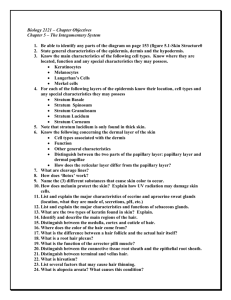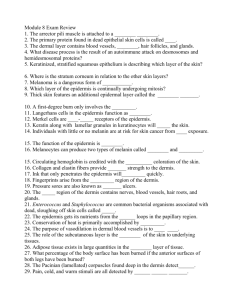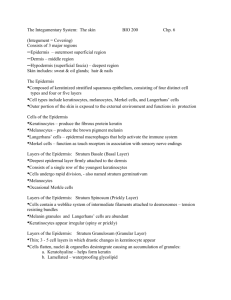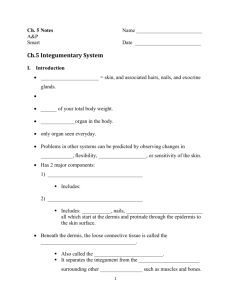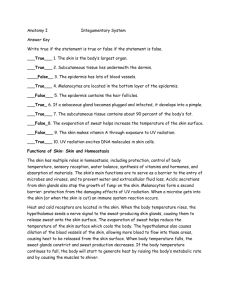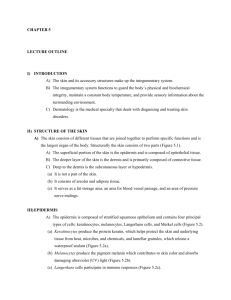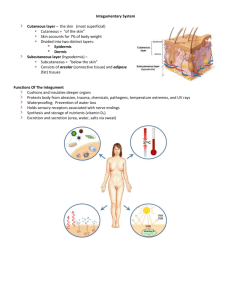File - Coach Simon/Biology/Anatomy
advertisement
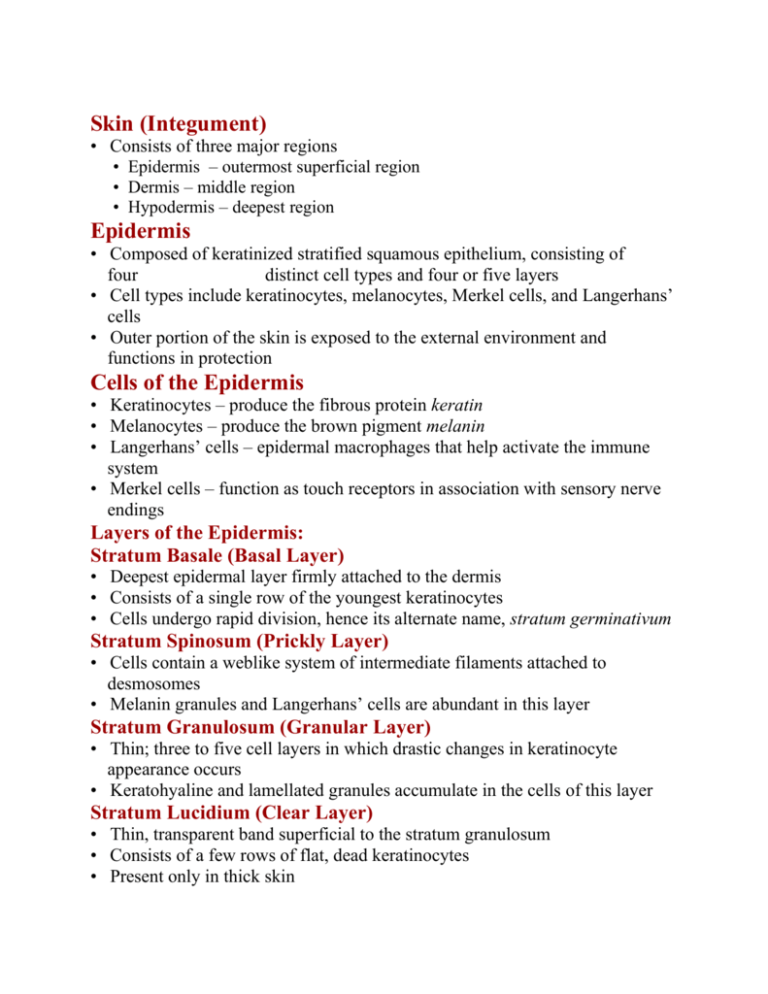
Skin (Integument) • Consists of three major regions • Epidermis – outermost superficial region • Dermis – middle region • Hypodermis – deepest region Epidermis • Composed of keratinized stratified squamous epithelium, consisting of four distinct cell types and four or five layers • Cell types include keratinocytes, melanocytes, Merkel cells, and Langerhans’ cells • Outer portion of the skin is exposed to the external environment and functions in protection Cells of the Epidermis • Keratinocytes – produce the fibrous protein keratin • Melanocytes – produce the brown pigment melanin • Langerhans’ cells – epidermal macrophages that help activate the immune system • Merkel cells – function as touch receptors in association with sensory nerve endings Layers of the Epidermis: Stratum Basale (Basal Layer) • Deepest epidermal layer firmly attached to the dermis • Consists of a single row of the youngest keratinocytes • Cells undergo rapid division, hence its alternate name, stratum germinativum Stratum Spinosum (Prickly Layer) • Cells contain a weblike system of intermediate filaments attached to desmosomes • Melanin granules and Langerhans’ cells are abundant in this layer Stratum Granulosum (Granular Layer) • Thin; three to five cell layers in which drastic changes in keratinocyte appearance occurs • Keratohyaline and lamellated granules accumulate in the cells of this layer Stratum Lucidium (Clear Layer) • Thin, transparent band superficial to the stratum granulosum • Consists of a few rows of flat, dead keratinocytes • Present only in thick skin Stratum Corneum (Horny Layer) • Outermost layer of keratinized cells • Accounts for three quarters of the epidermal thickness • Functions • Waterproofing • Protection from abrasion and penetration • Renders the body relatively insensitive to biological, chemical, and physical assaults Dermis • Second major skin region containing strong, flexible connective tissue • Cell types include fibroblasts, macrophages, and occasionally mast cells and white blood cells • Composed of two layers – papillary and reticular Dermis: Papillary Layer • Papillary layer • Areolar connective tissue with collagen and elastic fibers • Its superior surface contains peglike projections called dermal papillae • Dermal papillae contain capillary loops, Meissner’s corpuscles, and free nerve endings Dermis: Reticular Layer • Reticular layer • Accounts for approximately 80% of the thickness of the skin • Collagen fibers in this layer add strength and resiliency to the skin • Elastin fibers provide stretch-recoil properties Hypodermis • Subcutaneous layer deep to the skin • Composed of adipose and areolar connective tissue Skin Color • Three pigments contribute to skin color • Melanin – yellow to reddish-brown to black pigment, responsible for dark skin colors • Freckles and pigmented moles – result from local accumulations of melanin • Carotene – yellow to orange pigment, most obvious in the palms and soles of the feet • Hemoglobin – reddish pigment responsible for the pinkish hue of the skin Sweat Glands • Different types prevent overheating of the body; secret cerumen and milk • Eccrine sweat glands – found in palms, soles of the feet, and forehead • Apocrine sweat glands – found in axillary and anogenital areas • Ceruminous glands – modified apocrine glands in external ear canal and secrete cerumen • Mammary glands – specialized sweat glands that secret milk Sebaceous Glands • Soften skin when stimulated by hormones • Simple alveolar glands found all over the body • Secrete an oily secretion called sebum Hair • Helps maintain warmth, alerts the body to presence of insects on the skin, and guards the scalp against physical trauma, heat loss, and sunlight • Filamentous strands of dead keratinized cells produced by hair follicles • Contains hard keratin, which is tougher and more durable than the soft keratin of the skin • Made up of the shaft projecting from the skin and the root embedded in the skin • Consists of a core called the medulla, a cortex, and an outermost cuticle Hair • Pigmented by melanocytes at the base of the hair Hair Follicle • Root sheath extending from the epidermal surface into the dermis • Deep end is expanded forming a hair bulb • A knot of sensory nerve endings (a root hair plexus) wraps around each hair bulb • Bending a hair stimulates these endings, hence our hairs act as sensitive touch receptors Hair Follicle Types of Hair • Vellus – pale, fine body hair found in children and the adult female • Terminal – coarse, long hair of eyebrows, scalp, axillary, and pubic regions Hair Thinning and Baldness • Alopecia – hair thinning in both sexes • True, or frank, baldness – genetically determined and sex influenced condition (i.e., male pattern baldness) Structure of a Nail • Scalelike modification of the epidermis on the distal, dorsal surface of fingers and toes Functions of the Integumentary System • • • • • • • Protection – chemical, physical, and mechanical barrier Body temperature Regulated by dilation (cooling) and constriction (warming) of dermal vessels Sweat glands increase secretions to cool the body Cutaneous sensation – exoreceptors sense touch and pain Metabolic functions – synthesis of vitamin D in dermal blood vessels Blood reservoir – skin blood vessels store up to 5% of the body’s blood volume • Excretion – limited amounts of nitrogenous wastes are eliminated from the body in sweat Skin Cancer • Basal cell carcinoma • Squamous cell carcinoma • Melanoma Basal Cell Carcinoma • • • • Least malignant and most common skin cancer Stratum basale cells proliferate and invade the dermis and hypodermis Slow growing and do not often metastasize Can be cured by surgical excision in 99% of the cases Squamous Cell Carcinoma • • • • Arises from keratinocytes of stratum spinosum Arise most often on scalp, ears, and lower lip Grows rapidly and metastasizes if not removed Prognosis is good if treated by radiation therapy or removed surgically Melanoma • Cancer of melanocytes is the most dangerous type of skin cancer • Melanomas have the following characteristics (ABCD rule): • A: Asymmetry; the two sides of the pigmented area do not match • B: Border is irregular and exhibits indentations • C: Color (pigmented area) is black, brown, tan, and sometimes red or blue • D: Diameter is larger than 6 mm (size of a pencil eraser) Melanoma • Treated by wide surgical excision accompanied by immunotherapy • Chance of survival is poor if the lesion is over 4 mm thick Burns • First-degree – only the epidermis is damaged • Symptoms include localized redness, swelling, and pain • Second-degree – the epidermis and upper regions of dermis damaged • Symptoms mimic first degree burns, but blisters also appear • Third-degree – involve entire thickness of the skin • Burned area appears gray-white, cherry red, or black, and there is no initial edema nor pain (since nerve endings are destroyed) Rule of Nines • Estimates the severity of burns • Burns considered critical if: • Over 25% of the body has second-degree burns • Over 10% of the body has third-degree burns • There are third-degree burns on face, hands, or feet Developmental Aspects of the Integument: Fetal • • • • Epidermis develops from ectoderm Dermis and hypodermis develop from mesoderm Lanugo – downy coat of delicate hairs covering the fetus Vernix caseosa – substance produced by sebaceous glands that protects fetus’s skin in the amnion Developmental Aspects of the Integument: Adolescent to Adult • Skin and hair become oilier and acne may appear • After one reaches the 20s and 30s, skin shows the effects of cumulative environmental assaults • Scaling and dermatitis become more common Developmental Aspects of the Integument: Old Age • • • • • Epidermal replacement of cells slows and skin becomes thinner Skin becomes dry and itchy Subcutaneous fat layer diminishes, leading to intolerance of cold Decreased elasticity and loss of subcutaneous tissue leads to wrinkles Decreased numbers of melanocytes and Langerhans’cells increase the risk of skin cancer

